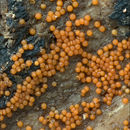ar
الأسماء في صفحات التنقل


Nectria peziza or yellow spot is an ascomycete fungus with bright yellow to orange globose fruiting bodies (0.2 – 0.4 mm across) found on rotting polypores, well rotted deadwood, bark, dung, and decaying cloth.[1][2] Its globular fruiting bodies (peritheca), quite large for the genus, may be isolated or crowded; they have a slightly prominent black dot at the top, the ostiolum, this being the entrance to the inner cavity;[3] the bodies often collapse into a cup-shape when dry[1] and the colour fades to pale yellow or whitish.
This fungus has an unusually large number of previous binomials, such as – Sphaeria peziza (1791); Hydropisphaera peziza (1822); Dialonectria peziza (1884); Cucurbitaria peziza (1898); Neuronectria peziza (1957); Byssonectria bryophila (1985); Sphaeria aurea (1823); Nectria aurea (1879); Dialonectria aurea (1884); Cucurbitaria aurea (1898); Byssonectria epigaea; and Nectria epigaea (1879).[4]
Nectra peziza belongs to the order Hypocreales within the class Sordariomycetes, usually recognized by their brightly coloured (usually red, orange or yellow), perithecial ascomata, or spore-producing structures.
Nectria peziza has been recorded from Africa (Seychelles); Asia (Japan, Pakistan); Caribbean Islands (Bermuda); Europe (Denmark, Germany); North America (USA, Canada); and New Zealand. It is recorded as growing on a wide range of tree species.[2] In the British Isles it has a wide range of distribution and has been found in England, Northern Ireland, Wales and Scotland.[5][6] N. peziza has even been found in Antarctica, growing in the Windmill Island group.[7]
Nectria peziza or yellow spot is an ascomycete fungus with bright yellow to orange globose fruiting bodies (0.2 – 0.4 mm across) found on rotting polypores, well rotted deadwood, bark, dung, and decaying cloth. Its globular fruiting bodies (peritheca), quite large for the genus, may be isolated or crowded; they have a slightly prominent black dot at the top, the ostiolum, this being the entrance to the inner cavity; the bodies often collapse into a cup-shape when dry and the colour fades to pale yellow or whitish.
Kausjas komuseen (Nectria peziza) on kottseente hulka kuuluv seeneliik.
Seent on leitud ka Eestist.[1]
Kausjas komuseen (Nectria peziza) on kottseente hulka kuuluv seeneliik.
Seent on leitud ka Eestist.